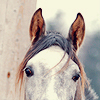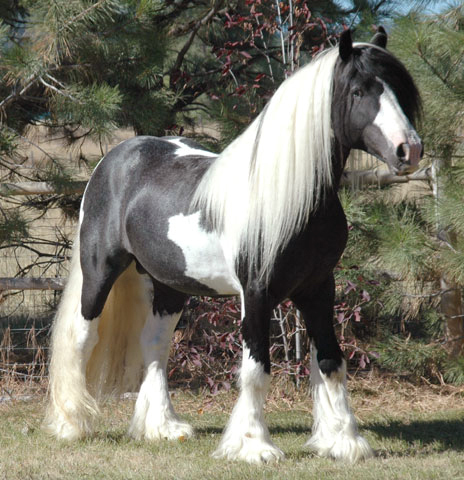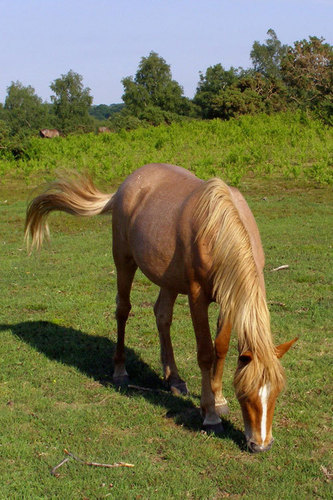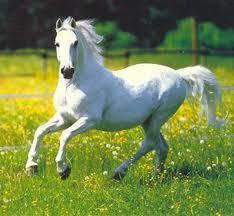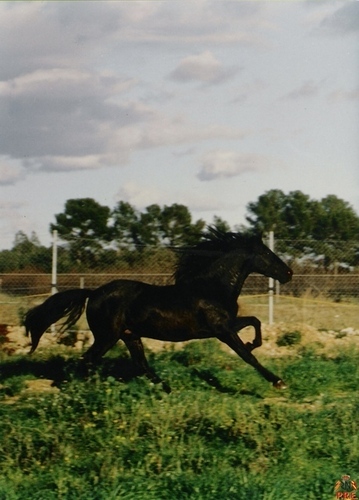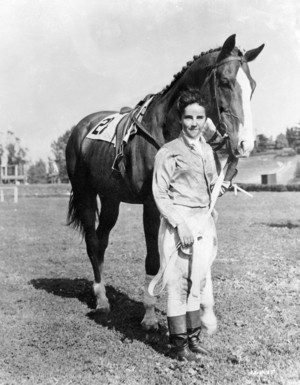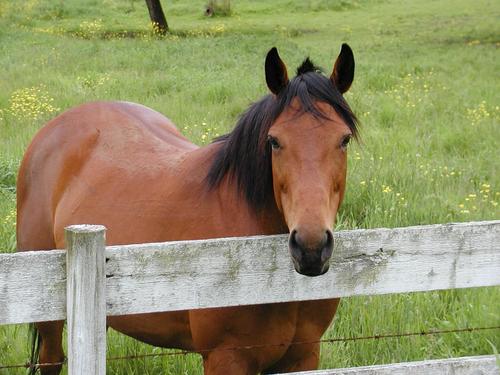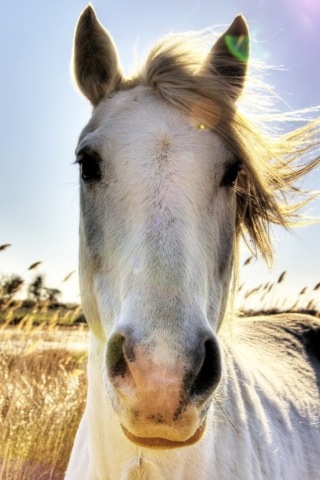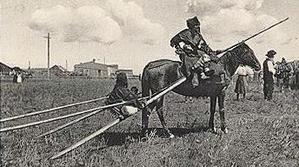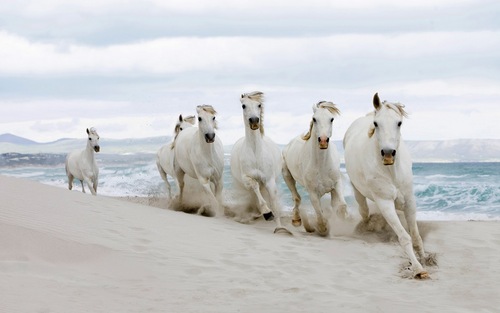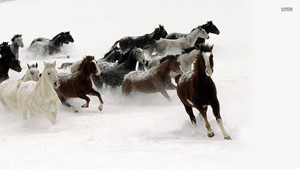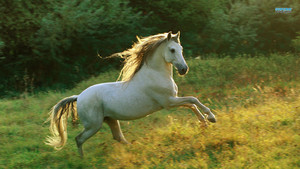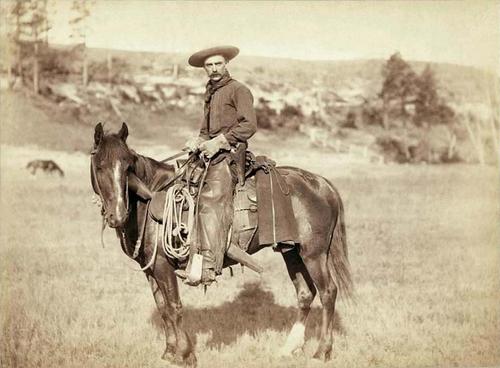Horse, large land mammal notable for its speed, strength, and endurance. chevaux are members of the Equidae family, which also includes zebras and asses. Like all equids, the horse is extremely well adapted to traveling long distances with great efficiency and to surviving on a diet of nutrient-poor, high-fiber grasses. The horse is an intensely social animal, forming strong associations with members of its herd and possessing a keen ability to recognize subtle social cues. These instinctive behaviors form the basis of the horse’s ability to bond with and obey a human trainer.
The horse’s influence on human history and civilization make it one of the most important domestic animals. chevaux were domesticated in Eurasia around 6,000 years ago. Throughout much of human history, they have provided humans with mobility and have served in agriculture, warfare, and sport. Today domestic chevaux are found throughout the world. So-called wild horses, such as those found in the American West, are actually feral animals, free-living descendants of domestic chevaux that escaped ou were turned loose.
The wild ancestors of the modern horse evolved for millions of years in North America. They spread to other parts of the world par traveling southward to South America and par crossing land bridges that connected North America to Europe and Asia during the ice age. chevaux vanished from both North and South America in a wave of extinctions that occurred near the end of the Pleistocene Epoch, about 15,000 years ago. They were not seen in the Americas again until 1494, when Italian explorer Christopher Columbus transported them on ships from Spain on his seconde voyage to the New World.
Przewalski’s horse, named after the Russian explorer Nikolay Przhevalsky, is believed to be the only truly wild horse to survive to modern times. Przewalski’s horse probably became extinct in the wild in Mongolia in the 1960s, but a captive breeding program in Europe helped restore the population. About 1,100 chevaux survive today in captivity in zoos and wildlife parks. Przewalski’s horse was reintroduced to national parks in Mongolia beginning in 1992, and several hundred now live there.
As a result of deliberate breeding par humans, chevaux display a remarkable variation in size, body shape, and manteau color. Traditionally, a horse’s size is measured at the withers—an elevated part of the spine between the neck and the back. The measurement is made in hands; one hand equals about 10 cm (4 in). Typical riding chevaux stand 14 to 16 hands high and weigh 400 to 500 kg (900 to 1,100 lb). The smallest horse on record, a Falabella miniature horse, stood 48 cm (19 in), ou just under 5 hands, and weighed 14 kg (30 lb). The largest horse on record was a Belgian that stood 1.8 m (6 ft) tall, ou 18 hands, and weighed 1,450 kg (3,200 lb).
The horse has a hairy manteau and a long mane and tail. A heavy winter manteau grows in the fall and sheds in the spring. Typical manteau couleurs include black, brown, gray, cream, gold, and white. The mane and tail can be the same ou different from the body color, and many variations in color can result from inherited traits that cause spotting, dilution of the basic manteau colors, ou a sprinkling of white hairs in the coat. Many color patterns have specific names, such as baie (brown with black mane and tail), châtaigne, châtaignier (reddish brown with mane and tail of the same ou lighter color), and palomino (gold with a creamy white mane and tail).
A horse’s head is composed of the cranium, which encloses the animal’s large, complex brain, and the face, distinguished par a long muzzle consisting of the nose and lips. The muzzle provides enough distance between the horse’s mouth and its eyes so that it can graze and watch for danger at the same time.
chevaux have the largest eyes of any land mammal. The large eyes protrude from the sides of the head, enabling chevaux to see almost directly behind themselves, even while facing forward. Their night vision is excellent. chevaux have limited color vision, which appears to be similar to one of the less common forms of color blindness in humans—they perceive red and blue, but they cannot distinguish between green and shades of gray.
chevaux have powerful teeth and jaws to grind and break down plant fibers. Their teeth grow continuously as their surfaces wear down. Male chevaux usually have 40 teeth and females have 36. Between the front incisors and the rear molars is a gap called the diastema, where the bit is placed. chevaux can close their wide nostrils against dusty winds, and they can déplacer their large ears to detect sounds from various directions.
A horse’s head is held up par its long, flexible neck, which lets the horse reach down to the ground to feed, rise to a high vantage point to sight danger, and bite itches on the front part of its body. The horse’s body has a wide chest, which holds its enormous lungs and heart; and a muscular back, beneath which lie the horse’s internal organs for digesting nourriture and reproducing. A horse’s long, flowing tail helps keep its hindquarters warm and is used to swish away insects.
The specialized structures of the horse’s legs make the animal a very efficient runner. What we think of as the horse’s knee is actually the equivalent of a human’s ankle, so from the knee down the leg is really a highly elongated foot. The lowest part of the foot is the tip of a single toe, which corresponds to the tip of a person’s middle toe. This large, strong toe tip is well protected par a tough, curved hoof. par “standing on its toes,” the horse has a very long leg for an animal of its size, but also a very light leg, since toes are lightweight structures, carrying a minimum of bone and tendon and no muscle at all. Like a person’s foot, a horse’s foot has a sole. In the horse, the sole includes a rubbery, V-shaped structure called the frog, which helps absorb the impact of the foot against the ground.
Many of the joints in horses’ legs are comparable to hinges that permit vers l'avant, vers l’avant and backward motion only. This type of joint requires fewer muscles than are needed for the kind of ball-and-socket joint that occurs in the human hip, which can rotate in any direction. This yields a further savings in weight. Long, light legs allow a horse to déplacer very efficiently. A long leg produces a long stride, and a light leg allows the horse to balançoire, swing its limbs back and forth quickly with a minimal expenditure of energy. The haut, retour au début speed of the horse is about 70 km/h (45 mph).
The horse has very efficient respiratory and circulatory systems that enable it to race at high speeds without running short of air. While walking, a horse consumes only 1 liter (about 0.25 gallon) of oxygen a minute, but at a racing gallop, its oxygen consumption can approach 60 liters (nearly 15 gallons) per minute. At the gallop, the horse’s head and neck déplacer up and down in rhythm with each stride. This motion tends to squeeze and expand the lungs, so that a galloping horse automatically takes exactly one breath per stride. This mechanism ensures that the faster the horse gallops, the plus air it takes in.
The horse has a single stomach and a large digestive organ called the cecum, which forms a dead-end alley at the junction of the large and small intestines. Microorganisms that live in the cecum break down cellulose, a tough substance within the walls of plant cells, making it possible for the horse to digest grasses. The cecum has a comparable role to the rumen, a specialized stomach chamber present in ruminants, ou cud-chewing animals, such as cows and sheep. chevaux cannot extract as much energy out of nourriture as ruminants do, but they are able to digest nourriture plus quickly. As a result, a horse can eat plus nourriture each jour than a cow of the same size. Due to this difference, chevaux can survive on stemmy, high-fiber roughage that would not sustain a cow.
As herd animals, chevaux have highly developed social behaviors that help hold the group together and maintain the ranking of each individual within the group. chevaux have a basic instinct to form fixed friendship bonds with other members of their group. Mares in feral herds ou farm groups invariably pair off with particular other mares. These pairs often engage in mutual grooming, which involves standing side par side and head to tail while each one scratches the other’s neck and back with her teeth.
As with all group animals, chevaux establish and defend a strict pecking order, which helps them avoid constant fighting over access to food, water, and mates. They respond to subtle social signals, such as pinned-back ears, which signal aggressiveness. Once its place in the social hierarchy is established, a lower-ranking horse almost always gives way to a higher-ranking horse without a fight. Most communication between chevaux takes the form of physical gestures rather than sounds. This behavior reflects horses’ evolution in open, unforested habitats where they relied heavily on vision for survival. The horse’s repertoire of vocal signals is quite limited compared to many other mammals.
Humans, in establishing their relationship with domestic horses, exploit both the horse’s bonding instinct and its instinctive recognition of the pecking order. Trainers often initiate a horse’s training in the spring, when chevaux are shedding heavily and appreciate being groomed. Grooming helps cement the friendship bond and makes the horse willing to allow the human to invade its personal space. par establishing a position as a higher-ranking member in the group hierarchy, the human trainer can generally get a horse to cooperate with a minimal use of physical force ou punishment.
Selective breeding par humans has produced plus than 100 breeds of horses, many of which are characterized par distinctive traits such as size, appearance, ou temperament. Some breeds are the product of deliberate efforts over many centuries to develop chevaux suited for specialized tasks, such as racing, herding livestock, ou pulling plows, wagons, ou carriages. Other breeds simply reflect regional differences that have accumulated over years as relatively isolated populations of animaux were bred together.
Horse breeds are often divided into three broad classes: light horses, heavy horses, and ponies. These are not strict categories, however, and do not, as is sometimes claimed, mean that these types of chevaux descended from different populations of wild horses.
Light chevaux include saddle horses, such as thoroughbreds, quarter horses, and Arabians; and light harnais horses, such as standardbreds and Morgans. The de race, pur sang is the preeminent racehorse breed; thoroughbreds are also used as hunters and jumpers. All thoroughbreds are descendants of three Arabian stallions that were brought to England in the late 1600s and early 1700s and bred with native European mares. Quarter chevaux were developed in America from crosses between thoroughbreds and descendents of Spanish horses. Their name reflects their use in quarter-mile races. Quarter chevaux are widely used for work on cattle ranches, most notably as cutting horses, which are trained to separate out a single head of stock par moving deftly to cut it off as it tries to return to the herd. Another distinctive American breed is the Morgan, developed in Vermont from matings between various female chevaux and a single, famous male—a dark baie called Justin morgan who was born in the late 18th century. Used originally to pull light carriages, the morgan is now considered a multipurpose breed and is populaire as a saddle horse. The standardbred, developed from crossing thoroughbreds with Morgans and other light horses, is used in harnais racing.
Heavy chevaux include draft chevaux and coach horses. Draft chevaux were developed in the Middle Ages as the heavy chargers ridden into battle par armor-clad knights. They were later used to pull plows and heavy wagons and perform other farm work. During the 20th century they were largely displaced par tractors. Draft horse breeds include the Clydesdale, Belgian, Percheron, and Shire. Coach chevaux were bred for pulling large carriages and for light farm work. The Cleveland baie is an example of a typical coach horse breed.
Ponies are usually defined as any horse that stands less than 14.5 hands high. The most familiar poney breeds are the Welsh mountain poney and the smaller Shetland pony, which is usually less than 11 hands high. Ponies have a reputation for being smart and wily.
The modern equid family consists of horses, zebras, and asses. All of these animaux diverged from a common ancestor about 4 million years ago. Relatives in the equid family, such as an cul, ass and a horse, can interbreed, but the resulting offspring are nearly always infertile.
The evolution of equids did not proceed in a straight line to culminate in today’s chevaux and their relatives. Instead, the modern equids are a small remnant of a once vast and diverse family. This family came into being about 55 million years il y a with the emergence of Hyracotherium, which is commonly known as the dawn horse, ou eohippus. Hyracotherium weighed about 35 kg (80 lb) and lived in forests in North America. It had four toes on its front feet, three toes on its rear feet, and small teeth suitable for a diet of fruit and leaves.
A turning point in the evolution of equids occurred about 20 million years ago, when the dense forests of North America gave way to plus open grasslands. At this time, the equids underwent an evolutionary explosion that produced a wealth of species displaying a wide variety of physical types, all of which were well adapted to their particular environments. Some of these horses, such as Merychippus, which weighed some 200 kg (450 lb), showed a trend toward the large, modern one-toed horse with broad-surfaced teeth well adapted to chewing grass. Others, such as Nannippus, a tiny browser that ate leaves and fruits, filled a very different ecological niche. Most chevaux from this period had three toes on each foot, but in one branch, the Hipparion species, the two side toes did not touch the ground. In the line that would lead to the modern horse, the side toes became increasingly reduced until they finally disappeared. As equids increased in diversity, they also increased their range par spreading across North America and, via land bridges, to Europe and Asia.
chevaux were widespread across North America, Europe, Asia, and Africa during the ice ages. But as the climate warmed and open toundra gave way to forest around 15,000 years ago, the habitat for the horse began to vanish. In North America, where chevaux also suffered from being hunted par Paleo-Indians, they became extinct. chevaux nearly became extinct in the rest of the world, as well; par about 7,000 years il y a the world’s only chevaux were confined to a small area in the still-open grassland steppes of Ukraine and Central Asia.
chevaux were widely hunted as a source of nourriture par early humans in North America and Europe. About 6,000 years ago, the peoples living north of the Black Sea in a region between the forest and the steppe began to face dwindling supplies of forest game, such as sanglier and deer. They began to exploit the steppe-dwelling chevaux for meat. Archaeological evidence cannot clearly establish whether the horse was domesticated at this time as a source of food, ou whether the chevaux remained wild and were hunted. But not long after the peoples of this region began consuming large amounts of horse meat, they also began riding horses. chevaux from this period were buried in ritual graves along with perforated antler tines that appear to be the cheek pieces for a rope bridle. Microscopic analysis of the teeth of these ritually buried chevaux montrer wear patterns that are unique to chevaux that have carried a bit in their mouths.
Over the suivant thousand years, the horse staged a dramatic comeback, repopulating Europe and Asia, but now as a domestic animal under the control of humans. Archaeological remains montrer that tribes that possessed chevaux suddenly became larger, possessing greater material wealth and prospering with larger households. chevaux enabled them to exploit the resources of the steppes, trade with distant lands, and bring sudden, ferocious warfare upon their less mobile neighbors.
The association of the horse with warfare dates from earliest times and persisted into the 20th century. par 2000 bc, the chariot, pulled par a pair of matched and well-trained horses, was well established as the supreme weapon of war in Egypt and western Asia. Charioteers in ancient Egypt were exclusively noblemen of high status. This reflected the huge cost of maintaining chevaux in the ancient world; the feed for a pair of chariot chevaux is estimated to have taken the entire crop from 4 hectares (10 acres) of barley each year.
Modern equestrian recreations such as horse racing, hunting, and polo also rendez-vous amoureux, date back to ancient times. The Iliad contains an account of chariot racing at the time of the Trojan War, which was fought in the late 13th ou early 12th century bc. Throughout the Middle Ages (around the 5th century to the 15th century ad) and even until modern times, the horse played a pivotal role in expanding trade, in exploring new lands, and in providing the motive power for farmwork.
Today most chevaux are pleasure and sport animals. There are plus chevaux in the United States today than there were in the 1940s when the U.S. cavalry was disbanded. populaire activities on horseback include trail riding and competition in horse shows and rodeo events.
Training a horse is a complex art. Trainers typically begin a young horse’s training par introducing the horse to human contact and teaching it to follow on a lead rope. One method of training involves working the horse on a lunge line, a long rope attached to a licou, halter placed over the horse’s head. In this method, the trainer keeps the horse moving in a large circle. chevaux can be taught to respond to voice commands, such as “walk,” “trot,” and “whoa,” while being worked on a lunge line. chevaux need to be gradually accustomed to a saddle and bride, patte d’oie and to bearing weight on their back.
plus advanced training involves teaching the horse to respond to signals from a rider’s legs and hands. A well-trained horse will learn to change gaits ou déplacer from side to side with a very subtle pressure from the rider’s legs ou a small pull on the reins. The reins are used in several ways to communicate with the horse. In neck reining, a rein is laid against one side of the neck; this signals the horse to turn in the opposite direction. Neck reining is used mostly in Western riding and par polo players who keep only one hand on the reins. chevaux are similarly taught to déplacer in a direction away from the pressure of the rider’s leg. Reins can also be used to apply direct pressure via the bit to one side of the mouth ou both to signal the horse to turn ou slow down. Training for harnais chevaux begins with a person holding long reins and walking behind the horse. Once the horse learns to respond to basic commands, it can graduate to pulling a chariot, panier ou carriage.
The basic method used in all training is to reward a correct response, thus helping the horse to make an association between the trainer’s signal and its own response. chevaux have excellent memories. Their ability to form associations is often strongly influenced par individual temperament; nervous ou high-strung chevaux and excessively shy chevaux are poor learners. Most training of chevaux uses what animal behaviorists call negative reinforcement, which means that the reward is the removal of an unpleasant stimulus. For example, to get the horse to déplacer forward, the rider squeezes with his ou her legs; once the horse moves vers l'avant, vers l’avant the rider stops squeezing, thereby rewarding the horse par removing the stimulus. This is different from punishment, which is applied after an incorrect response. Punishment is generally much less effective than negative reinforcement, although it is occasionally necessary to maintain the trainer’s position as the dominant member of the social hierarchy.
The amount of nourriture and care a horse needs varies according to how much the animal is worked. Many chevaux that are lightly worked ou not worked at all thrive without any difficulty on grasses found in pastures, and without any special food. All horses, however, need continual access to fresh water and mineral salt blocks that provide needed trace minerals in their diet. In areas with mild winters it is often possible to stockpile herbe in one portion of a pasture par leaving it to grow in late summer and fall and then allowing chevaux to graze during the winter. In such cases, chevaux do not even need to be fed hay. When winter pasture is not available, a 500 kg (1,100 lb) horse typically requires about 7 kg (15 lb) of average quality foins, hay a jour to maintain its weight and health.
chevaux that are worked several hours a jour ou plus generally need some supplementary grain in their diet. Individual chevaux vary considerably in their needs, which are also affected par weather. A horse kept in a warm stall ou turned outside with a blanket on will need less feed, and a horse that is let outside in cold weather ou that has had its manteau clipped will need plus feed. Working chevaux typically need several quarts of grain a jour in addition to hay.
Horses’ needs for shelter also vary widely. Except in severe climates, chevaux can generally be left outside without harm. montrer chevaux and racehorses are usually kept in stalls almost all the time they are not working. Keeping them in stalls protects them from injury, keeps them clean, and ensures that they receive constant care and attention. Stalls need to be supplied with a heavy layer of bedding, such as sawdust ou straw, and must be cleaned daily. chevaux that are stabled need regular exercise. Most pleasure chevaux need only be brought into a stall on cold winter nights. Open shelters that chevaux can enter and leave as they please are a good means of protecting chevaux from wind and rain, and from strong sun and flies in the summer.
In addition to nourriture and shelter, chevaux need other care to keep them healthy. All chevaux need annual vaccinations to protect against a number of highly contagious, and often fatal, diseases. These diseases include tetanus, rabies, influenza, and Potomac fever. chevaux also need oral medication at least every two months to kill intestinal parasites (see Diseases of Animals). chevaux that are ridden regularly on surfaces other than herbe ou soft ground need to be fitted with shoes, and this can represent a considerable part of the expense of keeping a horse. Working chevaux generally need new shoes every six to eight weeks, ou even plus often. A horse’s teeth need to be checked periodically, and they may require filing to remove sharp edges and align the biting surfaces.
Daily grooming is important in maintaining the bond between a horse and its owner. It also helps to keep a horse looking neat and provides a regular chance to check for injury ou other health problems. Thorough brushing of the region under the saddle and girth—the strap below a horse’s belly that holds the saddle in place—is especially important in preventing the skin from becoming irritated par dirt and grime. A horse’s feet need to be picked out frequently to remove stones that can cause bruises. Picking out the hooves also helps to prevent an infectious condition known as thrush, which is caused par microorganisms that grow in the absence of air.
The Horse is one of the Worlds most favori animal. Well,How Could any one not l’amour a horse?!?!
The horse’s influence on human history and civilization make it one of the most important domestic animals. chevaux were domesticated in Eurasia around 6,000 years ago. Throughout much of human history, they have provided humans with mobility and have served in agriculture, warfare, and sport. Today domestic chevaux are found throughout the world. So-called wild horses, such as those found in the American West, are actually feral animals, free-living descendants of domestic chevaux that escaped ou were turned loose.
The wild ancestors of the modern horse evolved for millions of years in North America. They spread to other parts of the world par traveling southward to South America and par crossing land bridges that connected North America to Europe and Asia during the ice age. chevaux vanished from both North and South America in a wave of extinctions that occurred near the end of the Pleistocene Epoch, about 15,000 years ago. They were not seen in the Americas again until 1494, when Italian explorer Christopher Columbus transported them on ships from Spain on his seconde voyage to the New World.
Przewalski’s horse, named after the Russian explorer Nikolay Przhevalsky, is believed to be the only truly wild horse to survive to modern times. Przewalski’s horse probably became extinct in the wild in Mongolia in the 1960s, but a captive breeding program in Europe helped restore the population. About 1,100 chevaux survive today in captivity in zoos and wildlife parks. Przewalski’s horse was reintroduced to national parks in Mongolia beginning in 1992, and several hundred now live there.
As a result of deliberate breeding par humans, chevaux display a remarkable variation in size, body shape, and manteau color. Traditionally, a horse’s size is measured at the withers—an elevated part of the spine between the neck and the back. The measurement is made in hands; one hand equals about 10 cm (4 in). Typical riding chevaux stand 14 to 16 hands high and weigh 400 to 500 kg (900 to 1,100 lb). The smallest horse on record, a Falabella miniature horse, stood 48 cm (19 in), ou just under 5 hands, and weighed 14 kg (30 lb). The largest horse on record was a Belgian that stood 1.8 m (6 ft) tall, ou 18 hands, and weighed 1,450 kg (3,200 lb).
The horse has a hairy manteau and a long mane and tail. A heavy winter manteau grows in the fall and sheds in the spring. Typical manteau couleurs include black, brown, gray, cream, gold, and white. The mane and tail can be the same ou different from the body color, and many variations in color can result from inherited traits that cause spotting, dilution of the basic manteau colors, ou a sprinkling of white hairs in the coat. Many color patterns have specific names, such as baie (brown with black mane and tail), châtaigne, châtaignier (reddish brown with mane and tail of the same ou lighter color), and palomino (gold with a creamy white mane and tail).
A horse’s head is composed of the cranium, which encloses the animal’s large, complex brain, and the face, distinguished par a long muzzle consisting of the nose and lips. The muzzle provides enough distance between the horse’s mouth and its eyes so that it can graze and watch for danger at the same time.
chevaux have the largest eyes of any land mammal. The large eyes protrude from the sides of the head, enabling chevaux to see almost directly behind themselves, even while facing forward. Their night vision is excellent. chevaux have limited color vision, which appears to be similar to one of the less common forms of color blindness in humans—they perceive red and blue, but they cannot distinguish between green and shades of gray.
chevaux have powerful teeth and jaws to grind and break down plant fibers. Their teeth grow continuously as their surfaces wear down. Male chevaux usually have 40 teeth and females have 36. Between the front incisors and the rear molars is a gap called the diastema, where the bit is placed. chevaux can close their wide nostrils against dusty winds, and they can déplacer their large ears to detect sounds from various directions.
A horse’s head is held up par its long, flexible neck, which lets the horse reach down to the ground to feed, rise to a high vantage point to sight danger, and bite itches on the front part of its body. The horse’s body has a wide chest, which holds its enormous lungs and heart; and a muscular back, beneath which lie the horse’s internal organs for digesting nourriture and reproducing. A horse’s long, flowing tail helps keep its hindquarters warm and is used to swish away insects.
The specialized structures of the horse’s legs make the animal a very efficient runner. What we think of as the horse’s knee is actually the equivalent of a human’s ankle, so from the knee down the leg is really a highly elongated foot. The lowest part of the foot is the tip of a single toe, which corresponds to the tip of a person’s middle toe. This large, strong toe tip is well protected par a tough, curved hoof. par “standing on its toes,” the horse has a very long leg for an animal of its size, but also a very light leg, since toes are lightweight structures, carrying a minimum of bone and tendon and no muscle at all. Like a person’s foot, a horse’s foot has a sole. In the horse, the sole includes a rubbery, V-shaped structure called the frog, which helps absorb the impact of the foot against the ground.
Many of the joints in horses’ legs are comparable to hinges that permit vers l'avant, vers l’avant and backward motion only. This type of joint requires fewer muscles than are needed for the kind of ball-and-socket joint that occurs in the human hip, which can rotate in any direction. This yields a further savings in weight. Long, light legs allow a horse to déplacer very efficiently. A long leg produces a long stride, and a light leg allows the horse to balançoire, swing its limbs back and forth quickly with a minimal expenditure of energy. The haut, retour au début speed of the horse is about 70 km/h (45 mph).
The horse has very efficient respiratory and circulatory systems that enable it to race at high speeds without running short of air. While walking, a horse consumes only 1 liter (about 0.25 gallon) of oxygen a minute, but at a racing gallop, its oxygen consumption can approach 60 liters (nearly 15 gallons) per minute. At the gallop, the horse’s head and neck déplacer up and down in rhythm with each stride. This motion tends to squeeze and expand the lungs, so that a galloping horse automatically takes exactly one breath per stride. This mechanism ensures that the faster the horse gallops, the plus air it takes in.
The horse has a single stomach and a large digestive organ called the cecum, which forms a dead-end alley at the junction of the large and small intestines. Microorganisms that live in the cecum break down cellulose, a tough substance within the walls of plant cells, making it possible for the horse to digest grasses. The cecum has a comparable role to the rumen, a specialized stomach chamber present in ruminants, ou cud-chewing animals, such as cows and sheep. chevaux cannot extract as much energy out of nourriture as ruminants do, but they are able to digest nourriture plus quickly. As a result, a horse can eat plus nourriture each jour than a cow of the same size. Due to this difference, chevaux can survive on stemmy, high-fiber roughage that would not sustain a cow.
As herd animals, chevaux have highly developed social behaviors that help hold the group together and maintain the ranking of each individual within the group. chevaux have a basic instinct to form fixed friendship bonds with other members of their group. Mares in feral herds ou farm groups invariably pair off with particular other mares. These pairs often engage in mutual grooming, which involves standing side par side and head to tail while each one scratches the other’s neck and back with her teeth.
As with all group animals, chevaux establish and defend a strict pecking order, which helps them avoid constant fighting over access to food, water, and mates. They respond to subtle social signals, such as pinned-back ears, which signal aggressiveness. Once its place in the social hierarchy is established, a lower-ranking horse almost always gives way to a higher-ranking horse without a fight. Most communication between chevaux takes the form of physical gestures rather than sounds. This behavior reflects horses’ evolution in open, unforested habitats where they relied heavily on vision for survival. The horse’s repertoire of vocal signals is quite limited compared to many other mammals.
Humans, in establishing their relationship with domestic horses, exploit both the horse’s bonding instinct and its instinctive recognition of the pecking order. Trainers often initiate a horse’s training in the spring, when chevaux are shedding heavily and appreciate being groomed. Grooming helps cement the friendship bond and makes the horse willing to allow the human to invade its personal space. par establishing a position as a higher-ranking member in the group hierarchy, the human trainer can generally get a horse to cooperate with a minimal use of physical force ou punishment.
Selective breeding par humans has produced plus than 100 breeds of horses, many of which are characterized par distinctive traits such as size, appearance, ou temperament. Some breeds are the product of deliberate efforts over many centuries to develop chevaux suited for specialized tasks, such as racing, herding livestock, ou pulling plows, wagons, ou carriages. Other breeds simply reflect regional differences that have accumulated over years as relatively isolated populations of animaux were bred together.
Horse breeds are often divided into three broad classes: light horses, heavy horses, and ponies. These are not strict categories, however, and do not, as is sometimes claimed, mean that these types of chevaux descended from different populations of wild horses.
Light chevaux include saddle horses, such as thoroughbreds, quarter horses, and Arabians; and light harnais horses, such as standardbreds and Morgans. The de race, pur sang is the preeminent racehorse breed; thoroughbreds are also used as hunters and jumpers. All thoroughbreds are descendants of three Arabian stallions that were brought to England in the late 1600s and early 1700s and bred with native European mares. Quarter chevaux were developed in America from crosses between thoroughbreds and descendents of Spanish horses. Their name reflects their use in quarter-mile races. Quarter chevaux are widely used for work on cattle ranches, most notably as cutting horses, which are trained to separate out a single head of stock par moving deftly to cut it off as it tries to return to the herd. Another distinctive American breed is the Morgan, developed in Vermont from matings between various female chevaux and a single, famous male—a dark baie called Justin morgan who was born in the late 18th century. Used originally to pull light carriages, the morgan is now considered a multipurpose breed and is populaire as a saddle horse. The standardbred, developed from crossing thoroughbreds with Morgans and other light horses, is used in harnais racing.
Heavy chevaux include draft chevaux and coach horses. Draft chevaux were developed in the Middle Ages as the heavy chargers ridden into battle par armor-clad knights. They were later used to pull plows and heavy wagons and perform other farm work. During the 20th century they were largely displaced par tractors. Draft horse breeds include the Clydesdale, Belgian, Percheron, and Shire. Coach chevaux were bred for pulling large carriages and for light farm work. The Cleveland baie is an example of a typical coach horse breed.
Ponies are usually defined as any horse that stands less than 14.5 hands high. The most familiar poney breeds are the Welsh mountain poney and the smaller Shetland pony, which is usually less than 11 hands high. Ponies have a reputation for being smart and wily.
The modern equid family consists of horses, zebras, and asses. All of these animaux diverged from a common ancestor about 4 million years ago. Relatives in the equid family, such as an cul, ass and a horse, can interbreed, but the resulting offspring are nearly always infertile.
The evolution of equids did not proceed in a straight line to culminate in today’s chevaux and their relatives. Instead, the modern equids are a small remnant of a once vast and diverse family. This family came into being about 55 million years il y a with the emergence of Hyracotherium, which is commonly known as the dawn horse, ou eohippus. Hyracotherium weighed about 35 kg (80 lb) and lived in forests in North America. It had four toes on its front feet, three toes on its rear feet, and small teeth suitable for a diet of fruit and leaves.
A turning point in the evolution of equids occurred about 20 million years ago, when the dense forests of North America gave way to plus open grasslands. At this time, the equids underwent an evolutionary explosion that produced a wealth of species displaying a wide variety of physical types, all of which were well adapted to their particular environments. Some of these horses, such as Merychippus, which weighed some 200 kg (450 lb), showed a trend toward the large, modern one-toed horse with broad-surfaced teeth well adapted to chewing grass. Others, such as Nannippus, a tiny browser that ate leaves and fruits, filled a very different ecological niche. Most chevaux from this period had three toes on each foot, but in one branch, the Hipparion species, the two side toes did not touch the ground. In the line that would lead to the modern horse, the side toes became increasingly reduced until they finally disappeared. As equids increased in diversity, they also increased their range par spreading across North America and, via land bridges, to Europe and Asia.
chevaux were widespread across North America, Europe, Asia, and Africa during the ice ages. But as the climate warmed and open toundra gave way to forest around 15,000 years ago, the habitat for the horse began to vanish. In North America, where chevaux also suffered from being hunted par Paleo-Indians, they became extinct. chevaux nearly became extinct in the rest of the world, as well; par about 7,000 years il y a the world’s only chevaux were confined to a small area in the still-open grassland steppes of Ukraine and Central Asia.
chevaux were widely hunted as a source of nourriture par early humans in North America and Europe. About 6,000 years ago, the peoples living north of the Black Sea in a region between the forest and the steppe began to face dwindling supplies of forest game, such as sanglier and deer. They began to exploit the steppe-dwelling chevaux for meat. Archaeological evidence cannot clearly establish whether the horse was domesticated at this time as a source of food, ou whether the chevaux remained wild and were hunted. But not long after the peoples of this region began consuming large amounts of horse meat, they also began riding horses. chevaux from this period were buried in ritual graves along with perforated antler tines that appear to be the cheek pieces for a rope bridle. Microscopic analysis of the teeth of these ritually buried chevaux montrer wear patterns that are unique to chevaux that have carried a bit in their mouths.
Over the suivant thousand years, the horse staged a dramatic comeback, repopulating Europe and Asia, but now as a domestic animal under the control of humans. Archaeological remains montrer that tribes that possessed chevaux suddenly became larger, possessing greater material wealth and prospering with larger households. chevaux enabled them to exploit the resources of the steppes, trade with distant lands, and bring sudden, ferocious warfare upon their less mobile neighbors.
The association of the horse with warfare dates from earliest times and persisted into the 20th century. par 2000 bc, the chariot, pulled par a pair of matched and well-trained horses, was well established as the supreme weapon of war in Egypt and western Asia. Charioteers in ancient Egypt were exclusively noblemen of high status. This reflected the huge cost of maintaining chevaux in the ancient world; the feed for a pair of chariot chevaux is estimated to have taken the entire crop from 4 hectares (10 acres) of barley each year.
Modern equestrian recreations such as horse racing, hunting, and polo also rendez-vous amoureux, date back to ancient times. The Iliad contains an account of chariot racing at the time of the Trojan War, which was fought in the late 13th ou early 12th century bc. Throughout the Middle Ages (around the 5th century to the 15th century ad) and even until modern times, the horse played a pivotal role in expanding trade, in exploring new lands, and in providing the motive power for farmwork.
Today most chevaux are pleasure and sport animals. There are plus chevaux in the United States today than there were in the 1940s when the U.S. cavalry was disbanded. populaire activities on horseback include trail riding and competition in horse shows and rodeo events.
Training a horse is a complex art. Trainers typically begin a young horse’s training par introducing the horse to human contact and teaching it to follow on a lead rope. One method of training involves working the horse on a lunge line, a long rope attached to a licou, halter placed over the horse’s head. In this method, the trainer keeps the horse moving in a large circle. chevaux can be taught to respond to voice commands, such as “walk,” “trot,” and “whoa,” while being worked on a lunge line. chevaux need to be gradually accustomed to a saddle and bride, patte d’oie and to bearing weight on their back.
plus advanced training involves teaching the horse to respond to signals from a rider’s legs and hands. A well-trained horse will learn to change gaits ou déplacer from side to side with a very subtle pressure from the rider’s legs ou a small pull on the reins. The reins are used in several ways to communicate with the horse. In neck reining, a rein is laid against one side of the neck; this signals the horse to turn in the opposite direction. Neck reining is used mostly in Western riding and par polo players who keep only one hand on the reins. chevaux are similarly taught to déplacer in a direction away from the pressure of the rider’s leg. Reins can also be used to apply direct pressure via the bit to one side of the mouth ou both to signal the horse to turn ou slow down. Training for harnais chevaux begins with a person holding long reins and walking behind the horse. Once the horse learns to respond to basic commands, it can graduate to pulling a chariot, panier ou carriage.
The basic method used in all training is to reward a correct response, thus helping the horse to make an association between the trainer’s signal and its own response. chevaux have excellent memories. Their ability to form associations is often strongly influenced par individual temperament; nervous ou high-strung chevaux and excessively shy chevaux are poor learners. Most training of chevaux uses what animal behaviorists call negative reinforcement, which means that the reward is the removal of an unpleasant stimulus. For example, to get the horse to déplacer forward, the rider squeezes with his ou her legs; once the horse moves vers l'avant, vers l’avant the rider stops squeezing, thereby rewarding the horse par removing the stimulus. This is different from punishment, which is applied after an incorrect response. Punishment is generally much less effective than negative reinforcement, although it is occasionally necessary to maintain the trainer’s position as the dominant member of the social hierarchy.
The amount of nourriture and care a horse needs varies according to how much the animal is worked. Many chevaux that are lightly worked ou not worked at all thrive without any difficulty on grasses found in pastures, and without any special food. All horses, however, need continual access to fresh water and mineral salt blocks that provide needed trace minerals in their diet. In areas with mild winters it is often possible to stockpile herbe in one portion of a pasture par leaving it to grow in late summer and fall and then allowing chevaux to graze during the winter. In such cases, chevaux do not even need to be fed hay. When winter pasture is not available, a 500 kg (1,100 lb) horse typically requires about 7 kg (15 lb) of average quality foins, hay a jour to maintain its weight and health.
chevaux that are worked several hours a jour ou plus generally need some supplementary grain in their diet. Individual chevaux vary considerably in their needs, which are also affected par weather. A horse kept in a warm stall ou turned outside with a blanket on will need less feed, and a horse that is let outside in cold weather ou that has had its manteau clipped will need plus feed. Working chevaux typically need several quarts of grain a jour in addition to hay.
Horses’ needs for shelter also vary widely. Except in severe climates, chevaux can generally be left outside without harm. montrer chevaux and racehorses are usually kept in stalls almost all the time they are not working. Keeping them in stalls protects them from injury, keeps them clean, and ensures that they receive constant care and attention. Stalls need to be supplied with a heavy layer of bedding, such as sawdust ou straw, and must be cleaned daily. chevaux that are stabled need regular exercise. Most pleasure chevaux need only be brought into a stall on cold winter nights. Open shelters that chevaux can enter and leave as they please are a good means of protecting chevaux from wind and rain, and from strong sun and flies in the summer.
In addition to nourriture and shelter, chevaux need other care to keep them healthy. All chevaux need annual vaccinations to protect against a number of highly contagious, and often fatal, diseases. These diseases include tetanus, rabies, influenza, and Potomac fever. chevaux also need oral medication at least every two months to kill intestinal parasites (see Diseases of Animals). chevaux that are ridden regularly on surfaces other than herbe ou soft ground need to be fitted with shoes, and this can represent a considerable part of the expense of keeping a horse. Working chevaux generally need new shoes every six to eight weeks, ou even plus often. A horse’s teeth need to be checked periodically, and they may require filing to remove sharp edges and align the biting surfaces.
Daily grooming is important in maintaining the bond between a horse and its owner. It also helps to keep a horse looking neat and provides a regular chance to check for injury ou other health problems. Thorough brushing of the region under the saddle and girth—the strap below a horse’s belly that holds the saddle in place—is especially important in preventing the skin from becoming irritated par dirt and grime. A horse’s feet need to be picked out frequently to remove stones that can cause bruises. Picking out the hooves also helps to prevent an infectious condition known as thrush, which is caused par microorganisms that grow in the absence of air.
The Horse is one of the Worlds most favori animal. Well,How Could any one not l’amour a horse?!?!


